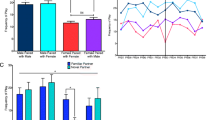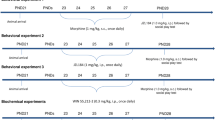Abstract
To clarify the influence of opioids on social play, the effects of morphine on playful and non-playful social behavior in juvenile rats was investigated under different conditions. Environmental variables employed were different (dim and intense) levels of illumination during testing, familiarity to the test cage, and different periods of social isolation prior to testing. Under dim light conditions, morphine markedly increased playful social behavior, such as pinning, boxing/wrestling and following/chasing, whereas non-playful social behavior such as social exploration and contact behavior was hardly affected. This effect of morphine was independent of duration of previous isolation and dose-dependent, with a maximal effect at 1.0 mg/kg. The mechanism of this effect is interpreted as an action on the rewarding aspects of play. A dose of 0.1 mg/kg of morphine abolished the initial suppression of play induced by unfamiliarity to the test cage, without influencing total levels of play. This may be an effect of morphine on the integration of sensory stimuli. Under intense light conditions, where playful behavior was completely suppressed, morphine itself hardly affected such behavior, but decreased some aspects of non-playful social behavior. These results suggest that in juvenile rats playful and non-playful forms of social behavior are differentially regulated. In addition, opioid systems may be involved at different levels in the regulation of social play.
Similar content being viewed by others
References
Aggleton JP, Mishkin M (1986) The amygdala: sensory gateway to the emotions. In: Emotion: theory, research, and experience. Biological foundations of emotion. 3rd edn. Academic Press, New York, pp 281–299
Arnsten AFT, Segal DS, Loughlin SE, Roberts DCS (1981) Evidence for an interaction of opioid and noradrenergic locus coeruleus systems in the regulation of environmental stimulus-directed behavior. Brain Res 222:351–363
Baenninger LP (1967) Comparison of behavioural development in socially isolated and grouped rats. Anim behav 15:312–323
Beatty WW (1983) Scopolamine depresses play fighting: a replication. Bull Psychon Sci 21:315–316
Beatty WW, Costello KB (1982) Naloxone and play fighting in juvenile rats. Pharmacol Biochem Behav 17:905–907
Beatty WW, Dodge AM, Dodge LJ, Panksepp J (1982) Psychomotor stimulants, social deprivation and play in juvenile rats. Pharmacol Biochem Behav 16:417–422
Bekoff M (1972) The development of social interaction, play and metacommunication in mammals: an ethological perspective. Q Rev Biol 47:412–434
Bolles RC, Woods PJ (1964) The ontogeny of behavior in the albino rat. Anim Behav 12:427–441
Bozarth MA (1988) Opioid reinforcement processes. In: Rodgers RJ, Cooper SJ (eds) Endorphins, opiates and behavioural processes. Wiley, Chichester, pp 53–75
Calcagnetti DJ, Schechter MD (1992) Place conditioning reveals the rewarding aspect of social interaction in juvenile rats. Physiol Behav 51:667–672
File SE, Hyde JRG (1978) Can social interaction be used to measure anxiety? Br J Pharmacol 62:19–24
File SE, Rodgers RJ (1979) Partial anxiolytic action of morphine sulphate following microinjection into the central nucleus of the amygdala in rats. Pharmacol Biochem Behav 11:313–318
Fog R (1970) Behavioural effects in rats of morphine and amphetamine and of a combination of the two drugs. Psychopharmacologia 16:305–312
Hole G (1988) Temporal features of social play in the laboratory rat. Ethology 78:1–20
Holloway WR Jr., Thor DH (1983) Caffeine: effects on the behaviors of juvenile rats. Neurobehav Toxicol Teratol 5:127–134
Humphreys AP, Einon DF (1981) Play as a reinforcer for maze-learning in juvenile rats. Anim Behav 29:259–270
Iwamoto ET (1984) An assessment of the spontaneous activity of rats administered morphine, phencyclidine, or nicotine using automated and observational methods. Psychopharmacology 84:374–382
Jalowiec JE, Calcagnetti DJ, Fanselow MS (1989) Suppression of juvenile social behavior requires antagonism of central opioid systems. Pharmacol Biochem Behav 33:697–700
Kling AS, Brothers LA (1992) The amygdala and social behavior. In: Aggleton JP (ed) The amygdala: neurobiological aspects of emotion, memory, and mental dysfunction. Wiley-Liss, New York, pp 353–377
Koob GF (1992) Drugs of abuse: anatomy, pharmacology and function of reward pathways. Trends Pharmacol Sci 13:177–184
Meaney MJ, Stewart J (1979) A descriptive study of social development in the rat (Rattus norvegicus). Anim Behav 29:34–45
Meyerson BJ (1981) Comparison of the effects ofβ-endorphin and morphine on exploratory and socio-sexual behaviour in male rats. Eur J Pharmacol 69:453–463
Mogenson GJ (1987) Limbic-motor integration. In: Epstein AN, Morrison AR (eds) Progress in psychobiology and physiological psychology, 12th edn. Academic Press, New York, pp 117–170
Niesink RJM, Van Ree JM (1983) Normalizing effect of an adrenocorticotropic hormone (4–9) analog ORG 2766 on disturbed social behavior in rats. Science 221:960–962
Niesink RJM, Van Ree JM (1989) Involvement of opioid and dopaminergic systems in isolation-induced pinning and social grooming of young rats. Neuropharmacology 28:411–418
Normansell L, Panksepp J (1990) Effects of morphine and naloxone on play-rewarded spatial discrimination in juvenile rats. Dev Psychobiol 23:75–83
Panksepp J (1981) The ontogeny of play in rats. Dev Psychobiol 14:327–332
Panksepp J, Beatty WW (1980) Social deprivation and play in rats. Behav Neural Biol 30:197–206
Panksepp J, Bishop P (1981) An autoradiographic map of [3H]diprenorphine binding in rat brain: effects of social interaction. Brain Res Bull 7:405–410
Panksepp J, Siviy SM, Normansell L (1984) The psychobiology of play: theoretical and methodological perspectives. Neurosci Biobehav Rev 8:465–492
Panksepp J, Jalowiec JE, DeEskenazi FG, Bishop P (1985) Opiates and play dominance in juvenile rats. Behav Neurosci 99:441–453
Panksepp J, Normansell L, Cox JF, Crepeau LJ, Sacks DS (1987) Psychopharmacology of social play. In: Olivier B, Mos J, Brain PF (eds) Ethopharmacology of agonistic behaviour in animals and humans. Martinus Nijhoff Publishers, Dordrecht, pp 132–144
Pellis SM, Castañeda E, McKenna MM, Tran-Nguyen LTL, Whishaw IQ (1993) The role of the striatum in organizing sequences of play fighting in neonatally dopamine-depleted rats. Neurosci Lett 158:13–15
Pellis SM, Pellis VC (1991) Role reversal changes during the ontogeny of play fighting in male rats: attack vs. defense. Aggr Behav 17:179–189
Poole TB, Fish J (1975) An investigation of playful behavior inRattus norvegicus andMus musculus (Mammalia). J Zool Lond 175:61–71
Rodgers RJ, Cooper SJ (1988) Endorphins, opiates and behavioural processes. Wiley, Chichester
Siegel MA, Jensen RA (1986) The effects of naloxone and cage size on social play and activity in isolated young rats. Behav Neural Biol 45:155–168
Spanagel R, Herz A, Shippenberg TS (1992) Opposing tonically active endogenous opioid systems modulate the mesolimbic dopaminergic pathway. Proc Natl Acad Sci USA 89:2046–2050
Spear LP, Horowitz GP, Lipovsky J (1982) Altered behavioral responsivity to morphine during the periadolescent period in rats. Behav Brain Res 4:279–288
Takahashi LK (1986) Postweaning environmental and social factors influencing the onset and expression of agonistic behavior in norway rats. Behav Proc 12:237–260
Thor DH, Holloway WR Jr (1983) Scopolamine blocks play fighting behavior in juvenile rats. Physiol Behav 30:545–549
Van Ree JM (1987) Reward and abuse: opiates and neuropeptides. In: Engel J, Oreland L, Ingvar D, Pernow B, Rossner S, Pellborn LA (eds) Brain reward systems and abuse. Raven Press, New York, pp 75–88
Vanderschuren LJMJ, Niesink RJM, Spruijt BM, Van Ree JM (1994) Influence of environmental factors on social play behavior of juvenile rats. Physiol Behav, submitted
Wise RA (1989) Opiate reward: sites and substrates. Neurosci Biobehav Rev 13:129–133
Wolterink G, Van Ree JM (1989) Opioid systems in the amygdala can serve as substrate for the behavioral effects of the ACTH-(4–9) analog ORG 2766. Neuropeptides 14:129–136
Author information
Authors and Affiliations
Rights and permissions
About this article
Cite this article
Vanderschuren, L.J.M.J., Spruijt, B.M., Van Ree, J.M. et al. Effects of morphine on different aspects of social play in juvenile rats. Psychopharmacology 117, 225–231 (1995). https://doi.org/10.1007/BF02245191
Received:
Revised:
Issue Date:
DOI: https://doi.org/10.1007/BF02245191




